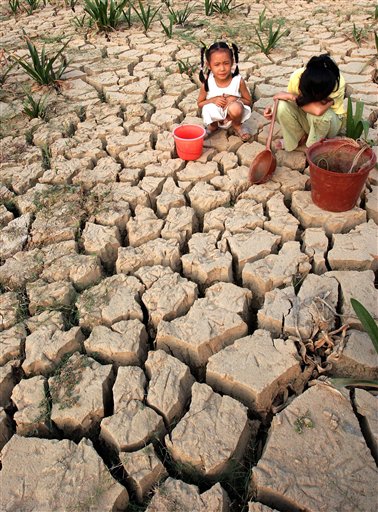This week in science

Chinese girls play on a parched land in Nanning, southern China’s Guangxi province, Saturday, Nov. 11, 2006. A severe drought since late October in southern China has left more than 2.4 million people short of drinking water, state media reported last week. (AP Photo/Color China Photo) **CHINA OUT**
Week of January 23 – January 29
Organism Created from Synthetic DNA
A team from the Scripps Research Institute in California created the first ever “semi-synthetic” organism by altering DNA in E. coli to have 6 bases instead of 4 bases. Every living thing has 4 bases: Thymine, Cytosine, Adenine, and Guanine. Adenine and Thymine molecules bond, creating a base pair, and Cytosine and Thymine molecules bond, creating the other base pair. The scientists created another base pair consisting of molecules referred to as X and Y. The team created this synthetic base in 2014. However, when they tried to incorporate this new base pair in the bacterium, it would become weak and die. Since then, the team has been attempting to figure out how to incorporate the new base pair without compromising the health of the cell. Three years later, they were able to incorporate the base base in the DNA sequence without harming the cell. The X and Y bases do not code for anything, thus not affecting the cell in anyway. The study’s goal was to prove that creating and introducing a synthetic base pair into a DNA sequence was possible. The team will continue working with the ultimate goal of creating bacteria that can produce certain proteins that can be used in medical treatments.
For more information: http://www.sciencealert.com/new-organisms-have-been-formed-using-the-first-ever-6-letter-genetic-code
China Invests in Cloud Seeding Project
This week politicians approved project to increase rainfall in the drought struck north eastern regions; over an area almost 2 times larger than France. The project is expected to take 3 years and cost 168 million dollars. The funds will be used to upgrade the existing aircrafts, buy four new planes, develop 900 rocket launchers, and create a network for the control systems. In order to increase rainfall, the Chinese Government will use a process called cloud seeding. The process of cloud seeding is surprisingly very simple. Planes drop silver iodide aerosols, or less commonly dry ice, on the clouds. The aerosols promote the growth of ice crystals. The ice crystals then become too heavy and start to fall. The crystals melt (assuming the temperature is above freezing) on their way down, making rain.
For more information: http://www.physics.org/article-questions.asp?id=98
https://www.theweathernetwork.com/news/articles/china-to-geoenginner-way-out-of-northwest-drought/78599
Microbes on Mars?
Researchers at the University of Arkansas have found evidence that a specific type of microorganism can survive on mars. These are called methanogens. Since they live in swamps and the intestines of cows, methanogens do not need oxygen or photosynthesis to live. In order to test if these organisms could survive, these scientists built a model of mars; there was a liquid that represented martian fluid, there was a really low atmospheric pressure, and it was in a really cold environment. What they discovered was that all four species of methanogens survived anywhere from three to 21 days. Some scientists believe that a species of methanogens are responsible for the methane on Mars, however, they are many other theories. Regardless if methanogens are responsible for the methane on Mars, this experiment shows the potential for microbes to live in the extreme conditions of other planets.
For more information: https://www.sciencerecorder.com/news/2017/01/24/microbes-may-able-survive-mars-study-reports/


Dr. Gil Wernovsky • Feb 14, 2017 at 4:40 pm
I am so proud of Jason Shoush! Keep up the good work!! Dr. Gil